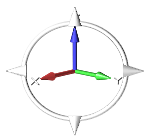View Rotator
Use the View Rotator to achieve finer control of rotation than is possible by using the mouse.
It appears when you hover over the colored axes located in the lower left corner of the modeling window.

Discover new features and enhancements.
New to Inspire Mold? Learn the basics here.
Inspire Mold is a modern simulation-driven design environment that lets you test, validate, correct, and optimize the design of injection-molded components.
Learn the basics of the Inspire user interface.
View a list of glossary terms and definitions.
Alternatives are a convenient way to manage design variations within your model.
An assembly is a list of parts.
If you want to prevent all or some of the parts in your model from overlapping, you can turn on collision detection in the Property Editor.
You can use the Configure toolbar on the Model Browser to activate and deactivate parts. This is called configuring your model.
Connection Stiffness allows for better approximation of axial and shear stiffness in grounded fasteners, grounded joints, and cylindrical supports.
A controller is provided as a way to try and reach a desired (target) value by means of a feedback control loop.
Context menus contain commands that allow you to edit a selected item, and are available for parts, entities, and tools on the ribbon.
The Demo Browser (F7) displays a list of demo models packaged with the software.
A design space is the initial geometry that forms the boundary of the optimized shape.
The installation directory is the location where the application was installed.
An instance is a copy of a part that is linked to the original part.
A load case is a set of loads and supports, displacements, accelerations, and temperatures that act on a model at one time.
The mass moment of inertia is calculated at the part's center of mass with respect to the global axis orientation.
The Model Browser shows all of the objects in your model in a tree structure.
The modeling window, sometimes referred to as the graphics area or window, is where you interact with your model.
Mouse controls are used to pan, zoom, and rotate the model.
In Inspire, there are two basic methods of displaying 3D objects on a 2D plane: perspective projection, which takes perspective effects into account; and orthographic projection, which does not.
All of the properties of a part can be directly accessed through the Property Editor.
A part is a geometric object made up of any combination of solids, surfaces, and curves. It can also be a mesh.
In Inspire, there are two basic methods of displaying 3D objects on a 2D plane: perspective projection, which takes perspective effects into account; and orthographic projection, which does not.
Applying pretension to bolted and screwed connections allows a more complete understanding of the behavior of a structure.
The principal axes or global axes are the x, y, and z axes in the View Rotator.
Motors and actuators have a profile option on the microdialog that allows you to change how the shaft moves as time elapses.
The Property Editor shows all the properties of a selected object and allows you to edit them.
The ribbon allows you to quickly access tools and standard functions, and is located at the top of the Inspire workspace.
The Screen Capture tool saves an image of your model with a white background.
The Snaps Filter icon ![]() is located in the lower right corner of the application window. It opens the snaps menu.
is located in the lower right corner of the application window. It opens the snaps menu.
Standard views are a convenient way to rotate your model to a set camera angle. Top, bottom, front, back, right, left, and several isometric views are available.
The status bar displays model status information and includes the snaps filter and unit system selector.
Suppress and Unsuppress joints, fasteners, and motion entities in a model.
Use the Unit System Selector to change the display units used in the user interface. (These can be the same or different as the modeling units, which are set in the Preferences.)
The view controls are located in the lower left corner of the modeling window.
When in sketch mode, the Rotate to Closest Principal Axes ![]() icon is replaced with the View Normal to Grid
icon is replaced with the View Normal to Grid ![]() icon in the view controls.
icon in the view controls.
Use the View Rotator to achieve finer control of rotation than is possible by using the mouse.
Most tools on the ribbon include text prompts beneath the tool or guide bar that explain what to do next. These prompts are a form of user assistance called workflow help.
Learn keyboard shortcuts and mouse controls for common operations.
Start using Inspire Mold with our interactive tutorials.
Create and modify sketch curves, PolyNURBS, surfaces, and solids.
Set up your model parts, materials, runner system, and tooling prior to analysis.
Run an injection molding analysis to minimize defects and prevent manufacturing problems.
Got questions? We have answers!
New to Inspire Mold? Learn the basics here.
View a list of glossary terms and definitions.
Use the View Rotator to achieve finer control of rotation than is possible by using the mouse.
Use the View Rotator to achieve finer control of rotation than is possible by using the mouse.
It appears when you hover over the colored axes located in the lower left corner of the modeling window.

(c) Altair Engineering, Inc. All rights reserved.